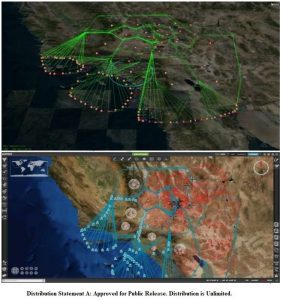
Photo By John Higgins | The main screens for the Electronic Warfare Planning and Management Tool or EWPMT, Program Manager Electronic Warfare & Sensors (PM EW&C) main system for processing electronic warfare effects. The EWMPT provides the initial integrated Electronic Warfare System (IEWS) capability by coordinating and synchronizing operations across the Army Intelligence, Opersation and Signal staff sections within the command post from Army battalions to the joint task force level. EWPMT is the command and control component of Intelligence Electronic Warfare & Sebsors and allows the maneuver commander the ability to seize, retain, and exploit the advantage within the electromagnetic spectrum (EMS) by enabling Multi-Function Electronic Warfare and Defensive Electronic Attack synchronization. This product among mother others, was part of the reason PM EW&C the Program Manager of the Year Award. (Courtesy Photo)
By John Higgins, PEO IEW&S Public Affairs
Project Manager Electronic Warfare and Cyber is known for innovation, so much so that this year they won the Program Manager of the Year for 2019.
To keep that streak, and to ensure the safety of military members and their industry partners, PM EW&C, conducted a virtual industry day.
More than six hundred people from across the United States tuned into a meeting with briefs provided by Col. Kevin Finch, the PM for EW&C, Tanya Peel, Acquisition Director and Fran Orzech, Chief, Technical Management Division.
“Up front what we wanted to do was show the opportunities for current and potential industry partners that exist in our current and future portfolios,” Finch said.
Peel, briefed those opportunities for the next four fiscal years, briefing key areas that will need expertise and skill in the coming years to include a broad need for many EW&C products, Terrestrial Layer System Software and the Sustainment of same, as well as three opportunities related to the Electronic Warfare Planning and Management Tool or EWPMT.
“As you look at our systems,” Finch said to the virtual attendees, “you’ll see a trend with what we are trying to do: we want integrated capabilities that can be upgraded easily over the life cycle of the system. Why? To address the threat now and address the threat in the future.”
Finch went on to say that systems must be compatible and modular, and that is why EW&C has been at the forefront of Open Systems Architecture broadly and the C4ISR/EW Modular Open Suite of Standards or CMOSS specifically.
Finch also highlighted the Universal Test Set, a ruggedized signal and radio test kit that was created to ensure, across many systems, that signal warfare equipment and operations are working.
Finch addressed three key layers of the systems his team have been fielding and are developing. The Foundational layer, where baselines for software and hardware design and production will begin, the Terrestrial Layer, where the boots on the ground will use the technology most directly and the Aerial Lawyer, where systems like Multi-Function Electronic Warfare-Air Large (MFEW Air-L) and its future variations, like the projected MFEW Air Small, will augment intelligence in real time to Soldiers on the ground.
Orzech briefed technology needs for EW&C and what innovations industry partners should bring to the table.
“The convergence of signal and cyber warfare is going to be key in the coming years,” Orzech said. “When you look at this list [of capabilities] these are based on current needs and projected needs.”
Orzech went on to say that making technology smaller, or miniaturization, will become more and more important and a constant push to improved current techniques to outpace older threats while also preparing for new threats is a core need for Electronic Warfare Capability.
Finch and his team briefed for two hours, ensuring a high level of detail about what PM EW&C needs, where it is now in terms of capability and where it needs to go, with plans laid out – for now – until the year 2034.
